London to North Cyprus by Train and Bus
Istanbul Day Three
Friday 17th August (Istanbul)
Woke a little early today, as I have to check out of the hotel before I'm picked up for my tour, which again was prompt at 8.45. One minor panic at the reception desk when they couldn't find my passport. It wasn't with all the others. It was eventually found at the bottom of the filing cabinet.
There are six of us today from this hotel and one from another. To get to our rendezvous point, the coach had to "turn and face the opposite direction" (in driving instructor parlance).
Question. How do you turn a 26ft long coach in a 25ft wide road?
Answer (UK). Drive 500 yards to the roundabout and go round it.
Answer (Turkey). Utilise as much of the pavement as you need and do a 9 point turn. If you are near a bend in the road and can block two lines of tram tracks at the same time, so much the better.
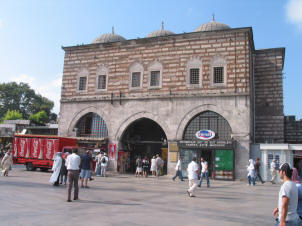 |
| Istanbul Spice Market |
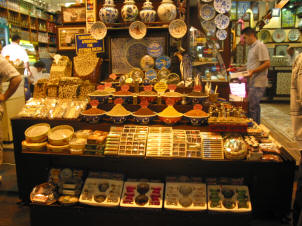 |
| A typical Market Stall |
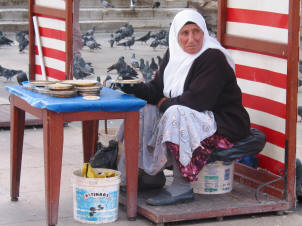 |
| "Feed the Birds" Outside the Spice Market |
Our coach filled up for the tour itself. The guide was very knowledgeable and clear with his information. Our first port of call was the spice bazaar. The trade in spices was very important to the Ottomans, and this bazaar is one of the oldest in the city. Although other things are now sold here, spices predominate, and the whole area has an exotic smell about it. It was built mainly with the proceeds of Egyptian taxes, hence is commonly known as the Egyptian Bazaar.
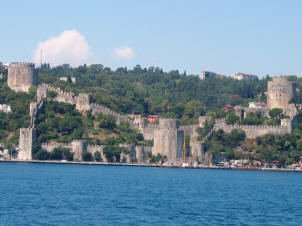 |
| The Rumeli Fortress |
I don't know what it is about me, but wherever I go I seem to get asked for directions. Today I was stopped by an American who wanted to get to the Blue Mosque. This I did, and when I told him it was 10 or 15 minutes walk, he said he'd get a cab. "Don't do that", I said. "Take a tram.", and explained where the tram went from and the system of payments for tickets. (Which I'd only just found out myself 10 minutes previously!) Maybe my tourism background shows. Perhaps I should stop walking round holding an umbrella with a union jack on it up in the air.
On to the yacht "Bosphorus Princess" for a trip alongside the European and Asian coasts. For obvious reasons there was some duplication with yesterday's cruise, but it was interesting all the same. During this trip we got a good view of the Rumeli fortress, built by the ottoman conqueror of Istanbul in 1453 to protect and control the Bosphorus. The main tower was completed in just over 4 months. Because if the number of nations bordering on to the Black Sea, the Bosphorus has always been international waters.
Lunch was at a different restaurant today, and the fare much more Turkish in style.
After lunch, we went on to the Dolmabahce Palace. By the middle of the 19th century, the Ottomans (at least the aristocracy) were becoming more influenced by western dress and styles. The sultan was at that time still living at the Topkapi Palace. This, however, had been built in 1465, and he considered it rather old hat. (Or old turban, which he had stopped wearing. Perhaps that's where the expression comes from.) So the sultan had the Dolmabahce Palace built, and this became the official residence of the last six Sultans from 1856 to 1922.
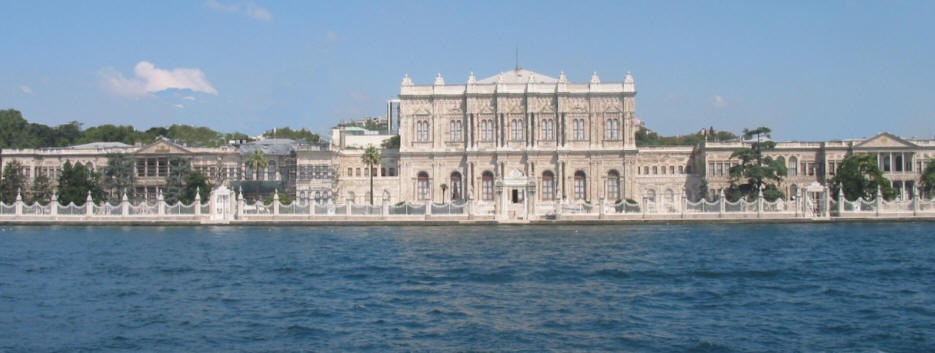 |
| The Dolmabahce Palace |
After the 1st World War and the defeat of the Ottoman empire, the Sultan's influence was greatly reduced, and a form of democracy was introduced. This, however, was greatly under the control of the army, and in 1922 at the instigation of the Generals (who at this stage had simply elected Ataturk as their spokesman), encouraged the Sultan and his family to go into exile, first to Nice and then to Rome. The last Sultan died in 1927 and is buried in Damascus. His descendents were allowed to return to Turkey in 1960. His grand daughter has written a book about the events of this time, but I'm not sure if it is still in print.
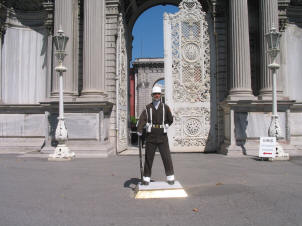 |
| The Palace Main Entrance |
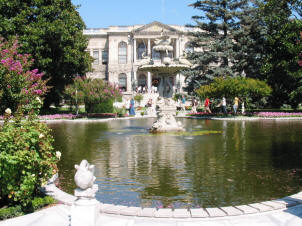 |
| The Palace Gardens |
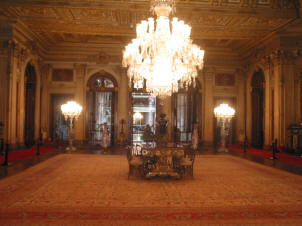 |
| The Palace Interior |
When the Sultan left the country, most of the Palace became a museum. Photography here is strictly controlled. If you want to take your camera in, it costs 6YTL, and to prove it, they attach a label to your camera. Flash is strictly forbidden, and it has been known for them to confiscate the cameras of offenders. Ataturk died here in 1938.
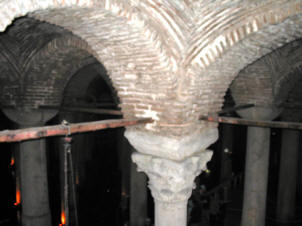 |
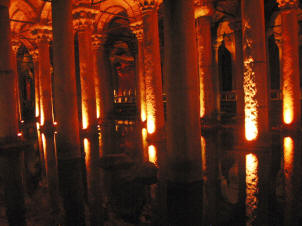 |
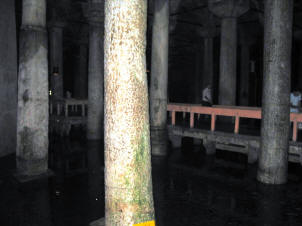 |
After the palace, the tour was programmed to visit the Camlica Hill, where I had been yesterday, so by leaving the tour at this stage I was able to visit the Byzantine Cistern.
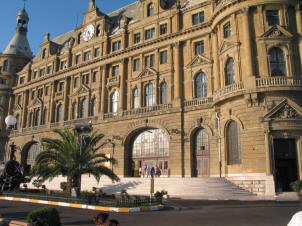 |
| Hyderpasha Station |
If you only have time to visit one attraction when in Istanbul, this has to be it Built in the 6th Century, it brought water 19Km to the city. Largely left derelict by the Ottomans, it was rediscovered in the 16th century. In 1985 it was cleaned and restored, eventually opening to the public in 1987.
I was picked up from my hotel by one of the Fezbus staff in Istanbul for the transfer to Hyderpasha station. I knew there was a shuttle boat between the two stations, but not having looked at the map, assumed it was a bit like the Woolwich Ferry. Not so. It was a 30 minute trip down the Bosphorus. I think by now I could have done a commentary!
Got to the station at 6.30 (for an 8pm departure. Too early again. Do I never learn?) Although the train was there, the sleeping cars were locked up till 7.30, so I had a little wander round. When I eventually boarded. I was told there was no restaurant car. As I'm on the train till 3pm tomorrow I made a quick dash to a cafe to organise some water. No time to sort out a sandwich, however.
The sleeping car is much more spacious than the others I've been in so far, so after a couple of hours reading, I settled down for the night.